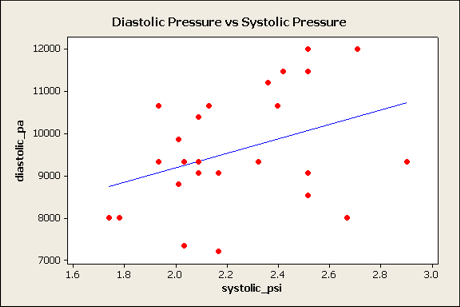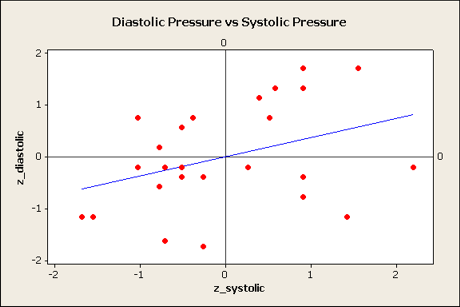 This
question wants you to generate a scatterplot and try to determine the value
of the correlation coefficient based on the scatterplot alone.
This
question wants you to generate a scatterplot and try to determine the value
of the correlation coefficient based on the scatterplot alone.In these instructions, I refer to different units such as PSI, Torrs, or Pascals. For your activity, I have removed the unit conversion to shorten up the activity, but haven't had time to go through and rework all the examples. Just use the variables you have.
The worksheet will be provided to you by the instructor. That is so that you won't know whose blood pressure and pulse rate is whose. Although gender and age may be related to blood pressure and pulse rate, we're not collecting that information for this project. If this were a more clinical study, we would collect and analyze that data and more.
The variables recorded are called systolic, diastolic, and pulse.
From now on, when you need to work with the project, open the one for your group.
 This
question wants you to generate a scatterplot and try to determine the value
of the correlation coefficient based on the scatterplot alone.
This
question wants you to generate a scatterplot and try to determine the value
of the correlation coefficient based on the scatterplot alone.
This example assumes that my predictor (x) variable is systolic blood pressure in psi (systolic_psi) and the response (y) variable is diastolic blood pressure in Pascals (diastolic_pa). Be sure you use your variables!
Now make a guess as to what you think the correlation coefficient would be. For my data, there appears to be a very slight positive correlation, but it's not very good at all. I would guess about r = 0.1.
My variables are diastolic_pa and systolic_psi. You should use whichever variables you're working with instead of the ones in my example. The units aren't necessary on the standardized variables because z-scores don't have units.
Note that you do not need to include the units with the standardized variables because there are no units. The standardized variables are found by subtracting the mean and dividing by the standard deviation. For example, if a diastolic blood pressure was 80 torr and it came from a sample with a mean of 86 torr with a standard deviation of 12 torr, then the standardized value would be (80 torr - 86 torr) / (12 torr) = (-6 torr) / (12 torr) = -0.5 (the units divide out, so there are no units).
 Repeat
the steps above, but use the z_ variables instead of the unitized
variables. You will notice that the graphs for the original and the standardized
variables look the same, only the scale has changed.
Repeat
the steps above, but use the z_ variables instead of the unitized
variables. You will notice that the graphs for the original and the standardized
variables look the same, only the scale has changed.
The important thing to realize is that the correlation coefficient, r, is the slope of the standardized regression line, not the one for the original data.
Find the coordinates of a point on the line. By point, I don't mean data points (the dots), I just mean a point somewhere on the line. You may be lucky enough to have a data point on the line that you could figure out the coordinates for, but probably not.
If I take a straightedge and go straight up from the 1 on the x-axis to the line, it looks like the y-value is about 0.4. The best fit line for a standardized plot will always pass through the origin, so now I have two points. From the point (0,0) to the point (1,0.4), my rise is 0.4 and my run is 1. Since slope is rise over run, my slope and correlation coefficient would be about 0.4/1 = 0.4.
I'm going to describe my predictor variable of systolic_psi and my response variable of diastolic_pa. Be sure you use your variables instead of mine.
You should get some output that looks like this.
Variable N N* Mean SE Mean StDev Minimum Q1 Median Q3
systolic_psi 25 0 2.2407 0.0599 0.2993 1.7403 2.0207 2.1657 2.5138
diastolic_pa 25 0 9605 279 1395 7199 8666 9333 10666 Variable Maximum
systolic_psi 2.9005
diastolic_pa 11999
Copy the sample size, mean, and standard deviation onto your activity sheet.
I'm going to find the correlation between my variables of systolic_psi and diastolic_pa. Be sure you use your variables instead of mine.
You will get something that looks like this. The first number is the correlation coefficient. The second number is the p-value.
Pearson correlation of systolic_psi and diastolic_pa = 0.369
P-Value = 0.069
Now, repeat these steps, but put the response variable first and the predictor variable second.
I'm going to describe my predictor variable of systolic_psi and my response variable of diastolic_pa. Be sure you use your variables instead of mine
You will get a lot of information. The part we want for question 9 is just the first line of all that.
The regression equation is
diastolic_pa = 5749 + 1721 systolic_psi
There will be an "Analysis of Variance" table that is generated as part of the regression output from question 10. It looks something like this.
Analysis of Variance Source DF SS MS F P
Regression 1 6365998 6365998 3.63 0.069
Residual Error 23 40363404 1754931 Total 24 46729402
Copy down the numbers onto your activity sheet. Note that on the activity sheet, the "residual error" is abbreviated as "residual".
Use the explanation on your activity sheet about the ANOVA table to answer question 11.